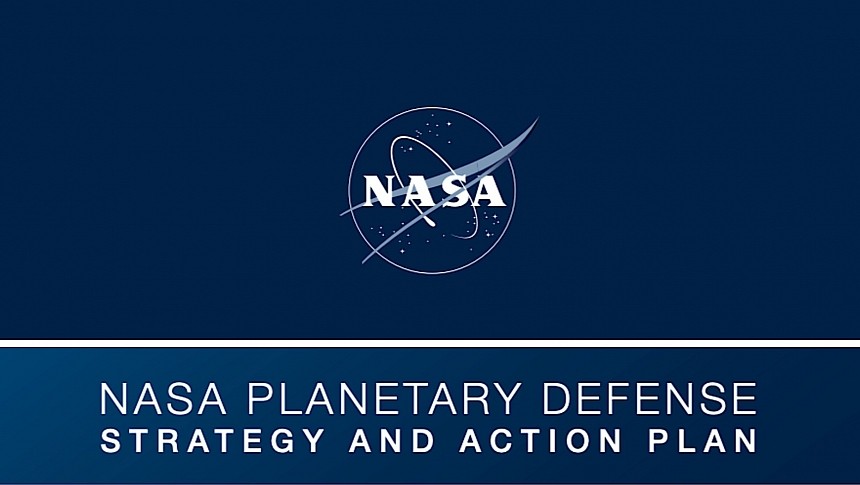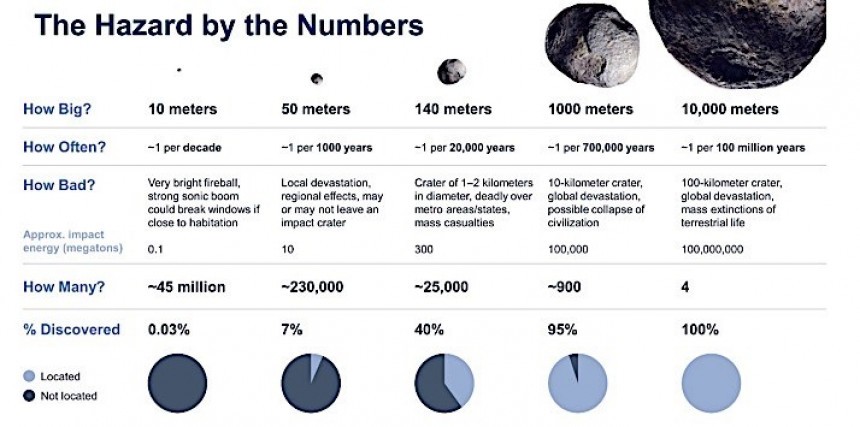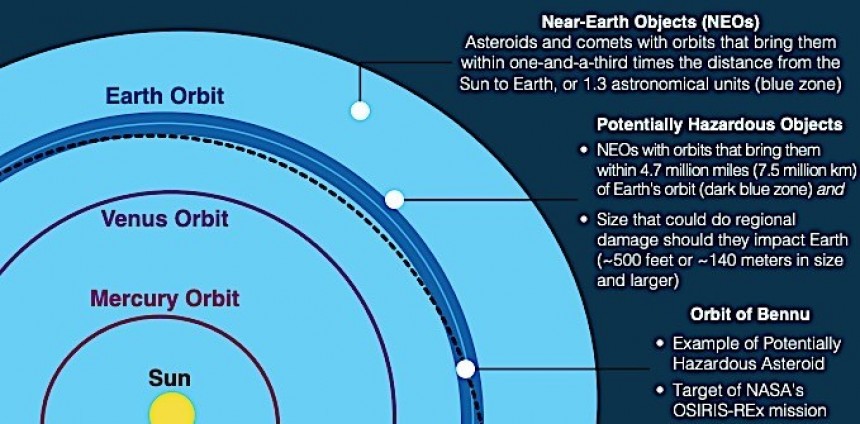Like it or not, believe it or not, it’s only a matter of time before a smaller or bigger rock from space comes crashing down on the surface of our planet. It’s an inescapable event, because the numbers are against us, but one whose effect can be at least limited if we properly prepare. And that’s exactly what NASA is doing with the 2023 National Preparedness Strategy and Action Plan for Near-Earth Object Hazards and Planetary Defense.
Known as the National Planetary Defense Strategy, the document was made public this week by the space agency and tries to help improve “detection, research, mission planning, emergency preparedness and response, international engagement, and internal U.S. government coordination on planetary defense.”
Building on a similar strategy published in 2018, the document takes into account what America and its agencies should and must do in case of an asteroid impact, should one occur over the next decade.
I said an asteroid impact is inevitable. You could contradict me, and you’d be right in pointing out the vastness of space, the complicated ways of celestial mechanics, and even our detection capabilities as reasons why the inevitable might not happen.
But the numbers I mentioned in the first paragraph, sourced from NASA and listed below, paint a very scary picture. They are included in the new defense strategy (attached as a PDF below this text), and they should be enough to make it painfully clear that an asteroid is coming our way from somewhere, and the only question is when it will hit.
In NASA’s own words, our planet’s orbit around the Sun is constantly crossed by millions of objects. It’s probably just chance that has kept us safe so far, and our human history has never recorded an impact with devastating effects on our species.
Of these millions of threats out there, the most concerning are those called NEO. That’s short for Near-Earth Objects and refers to asteroids and comets that come close to our blue marble – generally at least 1.3 astronomical units (that would be 1.3 times the distance between the Earth and the Sun).
NASA deemed these things dangerous, despite the still large distances involved, ever since 1998. In 2016, the agency created the Planetary Defense Coordination Office (PDCO) to track and keep an eye on NEOs, in the hope it will be able to warn us should one head our way.
NASA classifies NEOs in groups, depending on how large they are. Focusing just on five of these groups is enough to paint the dark picture of impact unavoidability.
We’ll start with the least dangerous asteroids, the ones that are smaller than 50 meters (164 feet) in diameter. There are literally millions of them, remnants of God knows what cosmic events. Because of their size, most of them would burn up in our planet’s atmosphere long before hitting the ground or the sea, so these are of little concern. Statistics show this kind of rock hits us at least once per decade.
The ones seized between 10 and 50 meters (32 to 164 feet), though, could cause some local, surface damage, but that’s not necessarily a reason for concern either – and even if it were, there’s not much we can do about them, because they are almost impossible to detect. We are aware and can track the orbits of under one percent of the millions of asteroids this small floating out there, and we know one hits one average every 1,000 years.
There are also hundreds of thousands of city killers in our solar system, asteroids sized larger than 50 meters. NASA throws a number in the defense strategy, 230,000, and adds that we only know where about eight percent of them are at any given time. That means there are over 200,000 pieces of rock that can wipe out entire urban areas floating in space, and we have no idea where they are.
Things are getting increasingly scarier as we move up this ladder. Some 25,000 objects larger than 140 meters (459 feet) spin around our world, and we only know where about half of them are. Each of them, including the unaccounted-for half, is capable of causing significant regional damage. Impact periodicity is estimated at 20,000 years.
As for global killers, asteroids sized more than one km (0.62 miles) in diameter, capable of causing planetary devastation when they strike every 700,000 years or so, there are about 1,000 of them in the space in our solar system. These are easier to spot, so NASA keeps an eye on about 95 percent of them - and it also assures us none of the known ones are currently a threat to our world.
The key aspect (and danger) NASA highlights throughout the document is the lack of proper knowledge when it comes to asteroids’ existence and their whereabouts. It’s like Earth is diving head-on and blind in a sea of asteroids, year after year, until it will eventually cross paths with one at just the wrong time.
The 2023 National Planetary Defense Strategy tries to find workarounds to this issue. The 46-page long document is filled with info, and we’ll go through it and break it down over the coming days in separate stories here on autoevolution. So stay tuned if you’re interested in learning exactly how NASA plans to protect us from asteroids.
Building on a similar strategy published in 2018, the document takes into account what America and its agencies should and must do in case of an asteroid impact, should one occur over the next decade.
I said an asteroid impact is inevitable. You could contradict me, and you’d be right in pointing out the vastness of space, the complicated ways of celestial mechanics, and even our detection capabilities as reasons why the inevitable might not happen.
But the numbers I mentioned in the first paragraph, sourced from NASA and listed below, paint a very scary picture. They are included in the new defense strategy (attached as a PDF below this text), and they should be enough to make it painfully clear that an asteroid is coming our way from somewhere, and the only question is when it will hit.
In NASA’s own words, our planet’s orbit around the Sun is constantly crossed by millions of objects. It’s probably just chance that has kept us safe so far, and our human history has never recorded an impact with devastating effects on our species.
NASA deemed these things dangerous, despite the still large distances involved, ever since 1998. In 2016, the agency created the Planetary Defense Coordination Office (PDCO) to track and keep an eye on NEOs, in the hope it will be able to warn us should one head our way.
NASA classifies NEOs in groups, depending on how large they are. Focusing just on five of these groups is enough to paint the dark picture of impact unavoidability.
We’ll start with the least dangerous asteroids, the ones that are smaller than 50 meters (164 feet) in diameter. There are literally millions of them, remnants of God knows what cosmic events. Because of their size, most of them would burn up in our planet’s atmosphere long before hitting the ground or the sea, so these are of little concern. Statistics show this kind of rock hits us at least once per decade.
The ones seized between 10 and 50 meters (32 to 164 feet), though, could cause some local, surface damage, but that’s not necessarily a reason for concern either – and even if it were, there’s not much we can do about them, because they are almost impossible to detect. We are aware and can track the orbits of under one percent of the millions of asteroids this small floating out there, and we know one hits one average every 1,000 years.
Things are getting increasingly scarier as we move up this ladder. Some 25,000 objects larger than 140 meters (459 feet) spin around our world, and we only know where about half of them are. Each of them, including the unaccounted-for half, is capable of causing significant regional damage. Impact periodicity is estimated at 20,000 years.
As for global killers, asteroids sized more than one km (0.62 miles) in diameter, capable of causing planetary devastation when they strike every 700,000 years or so, there are about 1,000 of them in the space in our solar system. These are easier to spot, so NASA keeps an eye on about 95 percent of them - and it also assures us none of the known ones are currently a threat to our world.
The key aspect (and danger) NASA highlights throughout the document is the lack of proper knowledge when it comes to asteroids’ existence and their whereabouts. It’s like Earth is diving head-on and blind in a sea of asteroids, year after year, until it will eventually cross paths with one at just the wrong time.
The 2023 National Planetary Defense Strategy tries to find workarounds to this issue. The 46-page long document is filled with info, and we’ll go through it and break it down over the coming days in separate stories here on autoevolution. So stay tuned if you’re interested in learning exactly how NASA plans to protect us from asteroids.








